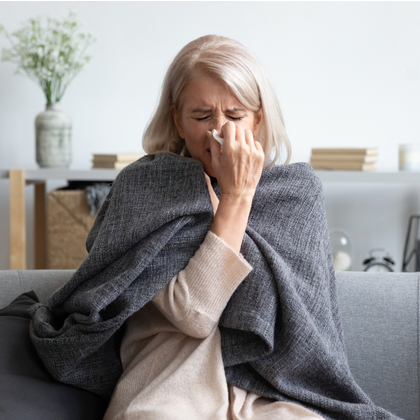According to the NHS colds and flu affect 15 million people each year in the UK, triggering symptoms such as sneezing, stuffy nose, sore throat, cough, headache, aches and pains and a high temperature.
Adults have two to four colds a year on average (ii), with women tending to catch more colds than men. Children, on the other hand, have around five to six colds a year (ii) because their immune systems are more vulnerable to infection (this may also explain why women have more colds than men, as in general they’re likely to interact more closely with children).
You can catch a cold at any time of the year, but you’re more likely to get one during the colder months (in the tropics colds are more common during the rainy season) (iii). Experts still don’t really know why this happens, but some believe when your nose is cold the cooler temperature helps cold viruses reproduce more effectively (iv). Flu is also more common in winter (v).
Both colds and flu are caused by viruses. There are more than 200 cold viruses called rhinoviruses and coronaviruses (iii), with no two viruses exactly the same. That’s why you may find some colds are short and mild while others may affect you more severely and last longer. It’s also thought that many people with cold symptoms may be infected with several viruses at the same time (iii). In addition to all of these cold viruses there are three types of flu virus (influenza A, B and C).
How are cold and flu viruses spread?
When someone who’s infected with a cold or flu viruses coughs or sneezes, they release tiny droplets that contain the virus. By breathing in one or more of these droplets, you may become infected by the virus. Similarly, you can become infected by touching a surface that has been sneezed or coughed over and then transferring the virus from your fingers by rubbing your nose or eyes (it’s thought that the cold virus can survive for several hours on inanimate objects and skin (vi)).
However, it isn’t the virus itself that produces your symptoms and makes you feel under the weather. When a cold or flu virus starts to invade your body, your immune system is activated and bombards areas such as the back of your throat and nose with white blood cells and other chemicals. So it’s actually your immune system that causes your runny nose and all those other symptoms.
How long do colds and flu last?
Once you have become infected by a cold virus, your symptoms will start to develop after one or two days and then gradually get better after a week or so. Flu symptoms appear suddenly one to three days after infection, and most people recover within a week (though you may feel very tired for longer).
Is it a cold or flu?
Both colds and flu are infections of the upper respiratory tract, but they are caused by different viruses. However, it can be difficult to tell whether you have a cold or flu because they share similar symptoms.
Generally speaking, the flu virus causes more intense symptoms while cold viruses are usually milder. Typical symptoms of a cold include sneezing, runny or stuffy nose, sore throat and a chesty cough. But if you have flu you may also have a fever (though occasionally colds can also be accompanied by a mild temperature), along with shivers, headache, aches and pains and very low energy.
Another difference between the two types of virus is that a cold can take a few days to develop: at first you may notice a tingling in your nose or throat, for example, with a runny nose, sneezing and congestion following; but with flu, your symptoms can start very suddenly.
More severe strains of flu – swine flu, for instance – can also produce other, more serious, symptoms such as vomiting and diarrhoea.
If you’re not sure which virus you’ve been affected by, here’s a quick checklist that may help:
Colds
Common symptoms:
-
Sneezing, runny or stuffy nose (congestion)
-
Sore throat
-
Cough (mild to moderate
Occasional symptoms:
Flu
Common symptoms:
-
Headache
-
Aches and pains (can be severe)
-
Fever (38-39ºC or higher)
-
Cough/bad chest (can be severe)
-
Exhaustion
-
Fatigue lasting up to two weeks
Occasional symptoms:
-
Sneezing, runny or stuffy nose (congestion)
-
Sore throat
The lifecycle of a cold or flu
If you have a cold and your symptoms are mild, it shouldn’t stop you from going to work or getting out and about if you feel up to it. However, you should take some common sense precautions to avoid passing the virus to those around you.
For instance, always cough or sneeze into a tissue and throw used tissues away as soon as possible. Also wash your hands straight after coughing or sneezing to avoid transferring any droplets containing the virus onto surfaces such as desks, tables, phones, computer keyboards and door handles.
However, if you have a particularly bad cold or flu with a temperature and a severe cough, or if you’re so tired or aching so much that you can hardly get out of bed, stay at home.
Here’s what happens during a typical cold or bout of flu:
Days 1-2:
Your symptoms may start gradually if you have a cold, and you may not realise you’ve been infected straight away. But if you have flu, your symptoms may start very suddenly, and you may have a headache, high temperature and ache all over.
What can you do?
Whether you have a cold or flu, try to take it as easy as possible in the first few days. Drink lots of fluids such as water and diluted juice, and avoid any strenuous activities.
Days 2-3:
If you have a cold, you may be starting to develop symptoms such as a tingly or sore throat, and you may start sneezing.
What can you do?
Keep taking it easy whenever possible and try to stay warm (have plenty of hot drinks: warm honey with lemon can be very soothing if you have a sore throat).
Days 3-5:
If you have a cold, you may be feeling a lot more congested now as your mucous begins to thicken and your nasal membranes become swollen. Your nose may feel more blocked and you may start to develop a chesty cough.
What can you do?
Keep resting and drinking plenty of fluids. You could also try a steam inhalation to help you breathe more easily (see below for more details).
Days 5-14:
At some stage during this period the virus will start to die off and your symptoms should begin to ease. Some colds can last for up to 14 days, and if you have flu you may feel tired out for longer than a week.
Should you see your GP?
If you’re generally fit and healthy there shouldn’t be any need to see your doctor for a cold or flu. Remember, antibiotics are not effective against viruses, so you won’t get any benefit from taking them. However, you may need to see your GP if you have any of the following:
-
You have a chronic illness such as asthma, diabetes or heart disease.
-
Your temperature is very high or your symptoms are very severe.
-
You have had a persistent cough that has lasted longer than three weeks.
-
You’re coughing up blood, you’re having chest pains or difficulty breathing, or your cough is becoming progressively worse.
Remedies to soothe cold and flu symptoms
If you have a cold or flu, the symptoms can make you feel miserable. And while there is no cure for a cold or flu virus, the good news is that there are several types of remedies that may provide relief and help you get on with your daily life while your body’s fighting off the infection (with all these remedies, do not exceed the maximum daily dose):
Pain relief
For symptoms such as a headache, muscle aches, sinus pain, sore throat and a mild temperature, simple pain relief tablets are often effective, such as paracetamol and ibuprofen.
Decongestants
Tablets, nasal sprays and capsules containing decongestant ingredients such as pseudoephedrine, phenylephrine, ephedrine, xylometazoline and oxymetazoline may help you breathe more easily by shrinking swollen tissues in your nasal passages. However, check with your GP before using any such products, as they often contain more than one active ingredient.
Other products that may help relieve congestion include vapour rubs (gels containing ingredients such as camphor, eucalyptus, pine and menthol oils), saline sprays and oils that you can add to hot water to produce an effective steam inhalation. These help to thin mucus and soothe your sinuses, and may be more suitable if you prefer a gentler approach to tackling your blocked nose.
Combination cold and flu remedies
All-in-one cold and flu medicines contain several ingredients that treat different symptoms. They may, for instance, contain a painkiller to treat a headache or aches and pains, caffeine for its stimulating effect and a decongestant to help you breathe. Some combination remedies may include antihistamines to dry out your nasal passages and help you sleep.
However, take care not to double dose any of the active ingredients when using combination cold and flu remedies (for instance, if you’re already taking a combination remedy that contains paracetamol or ibuprofen, don’t take other products – such as painkillers, cough medicines or lozenges – that include the same ingredients).
Cough medicines
The type of cough medicine you may need depends on the type of cough you have. If you have a tickle in your throat that sets off your coughing, you have a dry cough. With dry coughs, the throat and upper airways become inflamed, but you don’t produce any mucus.
Products that contain pholcodine and dextromethorphan may help to suppress a dry cough as they block the cough reflex by acting on the brain. On the other hand, you have a chesty cough if you produce thick mucus (or phlegm). This is your body’s way of getting rid of the mucus build-up on and around your chest. Products that contain expectorants such as guaifenesin and ipecacuanha are designed to help bring up mucus, making coughing easier.
Throat lozenges/sprays
If you have a sore throat, medicated lozenges can bring relief as they lubricate and soothe the lining of the throat. Medicated throat sprays are also suitable for severe sore throats, where taking pain relief tablets or sucking lozenges may be difficult. These sprays contain an anaesthetic ingredient that numbs the throat, offering fast relief.
Natural Remedies
While the jury’s still out on whether vitamin C can boost your resistance to colds or flu, numerous studies have found that taking it on a regular basis may reduce the symptoms of a cold as well as shorten its duration (vi).
Similarly, experts currently believe the traditional herbal remedy echinacea may not stop you getting a cold or flu. But there are studies that suggest it may help you recover from a cold faster, especially if you take it as soon as you notice any symptoms (vii).
Zinc is believed to be important for immune function (viii), and sucking zinc lozenges is thought to release ions that may directly stop viruses in the nose and throat. In one study, volunteers who took zinc lozenges several times a day while they had a cold recovered significantly faster than those who were in the placebo group (iv).
How to avoid catching a cold or flu virus
It may seem impossible to prevent catching a cold or flu, especially during the winter months when everyone around you seems to be sneezing and coughing. But there are some things you can do to increase your chances of avoiding a virus, including the following:
Eat as healthily as possible
Your immune system needs to be as strong as possible to fight off viruses, so make sure you eat a balanced diet with at least five portions of nutrient-packed fresh fruit and vegetables.
Take supplements
As well as having a healthy diet, taking a high-strength multivitamin and mineral supplement is often seen as an insurance policy against any shortcomings you may have in your nutrient intake. Meanwhile, taking garlic supplements may directly help protect against cold viruses, with one study suggesting it could make you almost two-thirds less likely to catch a cold (ix) (and if you do catch cold, by taking garlic you may recover slightly faster).
Keep warm
During the winter, wrap up well when you go outdoors, as experts believe cold weather can make your immune system less effective at fighting off viruses. Stay warm indoors too (turn your thermostat to at least 18ºC/64ºF).
Get moving
Moderate exercise is believed to help boost the immune system, so stay as active as possible, even in the colder months. Aim for 150 minutes of moderate-intensity physical activity each week (you can split this up into 30-minute sessions on five days of the week, or any way that suits your lifestyle).
Practice good hygiene
Get into the habit of washing your hands frequently, especially when there are people with cold and flu bugs around you, at home, at work and especially on public transport. Washing your hands can help to kill any viruses you may have picked up. Also keep a supply of antibacterial hand wipes or gel with you whenever you’re out and about, and use them regularly whenever you come into contact with people who are coughing and sneezing. If someone has a cold or flu at home or at work, keep office and household items and surfaces clean by using disinfectant sprays or wipes on a regular basis. Meanwhile, if you do catch a cold or flu, try to stop the virus spreading to other people by using a tissue to cover your mouth and nose whenever you sneeze or cough.
Having a cold or flu can make you feel miserable, but this guide should help you get through the worst of it a little more comfortably. To discover more information on a number of other common health conditions, visit our health library for some helpful advice.
References:
-
Available online: https://assets.publishing.service.gov.uk/government/uploads/system/uploads/attachment_data/file/216675/dh_130761.pdf
-
Available online: https://patient.info/chest-lungs/cough-leaflet/common-cold-upper-respiratory-tract-infections
-
Available online: https://patient.info/doctor/common-cold-coryza
-
Foxman EF. et al., Temperature-dependent innate defense against the common cold virus limits viral replication at warm temperature in mouse airway cells. PNAS. 2015 Jan 5;92(5):630-4.Available online: https://www.pnas.org/content/112/3/827
-
Available online: https://patient.info/infections/influenza-and-flu-like-illness
-
Available online: https://www.mayoclinic.org/diseases-conditions/flu/expert-answers/infectious-disease/faq-20057907
-
Hemila. H, Chalker. E, Douglas. B. Vitamin C for preventing and treating the common cold. Cochrane Database Syst Rev. 2010;(3):CD000980 etc. Available online: https://www.cochrane.org/CD000980/ARI_vitamin-c-for-preventing-and-treating-the-common-cold
-
Hoheisel. O, Sandberg. M, Bertram. S, et al. Echinagard treatment shortens the course of the common cold: a double-blind, placebo-controlled clinical trial. Eur J Clin Res. 1997;9:261-268. Available online: https://www.epistemonikos.org/documents/86b7d896dd2254a80e0a5f84cf69ac82e9ca68b6/
-
Barrett. B, Brown R, Locken K, et al. Treatment of the common cold with unrefined echinacea: A randomized, double-blind, placebo-controlled trial. Ann Intern Med. 2002;137:939-946. Available online: https://pubmed.ncbi.nlm.nih.gov/12484708/
-
Chandra RK. Trace element regulation of immunity and infection. J Am Coll Nutr. 1985;4:5-16. Available online: https://www.sciencedirect.com/science/article/pii/S0271531782801164
-
Fraker, PJ, Gershwin. ME, Good. RA, et al. Interrelationships between zinc and immune function. Fed Proc. 1986;45:1474-1479. Available online: https://pubmed.ncbi.nlm.nih.gov/3485544/
-
Mossad. SB, Macknin. ML, Medendorp. SV, et al. Zinc gluconate lozenges for treating the common cold: a randomized, double-blind, placebo-controlled study. Ann Intern Med. 1996;125:81-88. Available online: https://pubmed.ncbi.nlm.nih.gov/8678384/
-
Josling. P. Preventing the common cold with a garlic supplement: a double-blind, placebo-controlled survey. Adv Ther.2001;18:189-93. Available online: https://pubmed.ncbi.nlm.nih.gov/11697022/
-
Available online: https://www.nhs.uk/live-well/healthy-body/keep-warm-keep-well/
Related Posts
Disclaimer: The information presented by Nature's Best is for informational purposes only. It is based on scientific studies (human, animal, or in vitro), clinical experience, or traditional usage as cited in each article. The results reported may not necessarily occur in all individuals. Self-treatment is not recommended for life-threatening conditions that require medical treatment under a doctor's care. For many of the conditions discussed, treatment with prescription or over the counter medication is also available. Consult your doctor, practitioner, and/or pharmacist for any health problem and before using any supplements or before making any changes in prescribed medications.

Christine
Christine Morgan has been a freelance health and wellbeing journalist for almost 20 years, having written for numerous publications including the Daily Mirror, S Magazine, Top Sante, Healthy, Woman & Home, Zest, Allergy, Healthy Times and Pregnancy & Birth; she has also edited several titles such as Women’ Health, Shine’s Real Health & Beauty and All About Health.
View More



